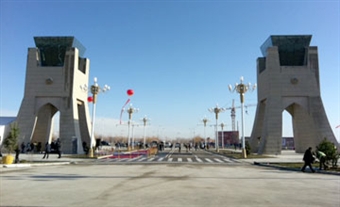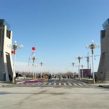
China and Central Asia in 2013
Publication: China Brief Volume: 13 Issue: 2
By:

In the last two years, China has emerged as the most consequential outside actor in Central Asia. As we have described in other writings, China’s ascension to this role has been largely inadvertent [1]. It has more to do with the region’s contemporary circumstances and China’s overall economic momentum than a concerted effort emanating from the Zhongnanhai. The implications for United States and NATO policy are nevertheless profound. Not only have the geopolitics of Eurasia shifted in ways little understood in Washington and Brussels, but the socio-political and physical undergirding of the post-Soviet space from Aktobe to Kandahar is being transformed.
Official Chinese policy in Central Asia is quiet and cautious, focused on developing the region as an economic partner with its western province Xinjiang whilst also looking beyond at what China characterizes as the “Eurasian Land Bridge…connecting east Asia and west Europe” (Xinhua, September 4, 2012). Chinese state-owned enterprises (SOEs) are active throughout the region on major infrastructure projects, but it is not clear how much they are being directed as part of some grand strategy as opposed to focusing on obvious profitable opportunities. The Shanghai Cooperation Organization (SCO), the main multilateral vehicle for Chinese regional efforts and reassuring engagement is a powerfully symbolic, but institutionally empty actor. Many smaller Chinese actors—ranging from shuttle traders to small-time entrepreneurs to schoolteachers and students posted to Confucius Institutes throughout the region—are the gradual vanguard of possible long-term Chinese investment and influence.
China’s engagement in Afghanistan is growing as U.S. and Western involvement wanes. Whether Chinese companies and diplomats remain in the event of a surge in violence and country-wide destabilization is a question that will be answered post-2014. For the moment, however, Chinese SOEs Metallurgic Corporation of China (MCC) and Jiangxi Copper are invested heavily in one of the world’s biggest copper mines at Mes Aynak (just southeast of Kabul) while China’s energy giant China National Petroleum Corporation (CNPC) is pumping oil in Afghanistan’s northern Amu Darya Basin. Currently, the firm is trucking the oil across the border to refineries in Turkmenistan, although plans are in place to develop a refinery on the Afghan side of the border. Plans also are moving forward for the construction of another string of the Central Asia-China pipeline from Turkmenistan to Xinjiang to pass through northern Afghanistan (Xinhua, June 6, 2012). CNPC and its subsidiaries already have cut deals with local authorities to ensure security in their operating areas. Should Afghanistan once again be split between a Pashtun south and a Tajik and Uzbek north, Chinese companies may have the relationships to continue operations under the protection of a new Northern Alliance. It seems that plans for the natural gas pipeline include distribution to local communities in northern Afghanistan [2].
Next door, at the source of the gas in Turkmenistan, CNPC and the Chinese government have carved out for themselves an envious position as one of the most influential outside players in Ashgabat, at least when talking in energy terms. The Central Asia-China pipeline, one of the most impressive feats in energy infrastructure construction, was completed in 18 months and now is slated to bring 60 billion cubic meters (bcm) of natural gas per year to China in the coming decades (Platts, August 31, 2011). These immense volumes—four times that planned for the Trans-Anatolian pipeline from the Caspian to Southeastern Europe—may require up to three different routes for the project’s separate strings. This route planned to traverse northern Afghanistan will offer an alternative to the more costly route through Uzbekistan and Kazakhstan [3].
Turkmenistan’s main energy and foreign policy priority at the moment is the realization of the Turkmenistan–Afghanistan–Pakistan–India (TAPI) pipeline southeast across Afghanistan to markets in Pakistan and India. During the project’s recent international road show, CNPC and Sinopec reportedly expressed interest in the project, even if it was unclear in what capacity [4]. For the sake of diversity, Turkmenistan’s leadership would almost certainly prefer non-Chinese companies investing in TAPI. During the Petrotech conference in New Delhi in October 2012, the acting Minister of Oil and Gas Industry and Mineral Resources Kakageldy Abdullaev made overtures to Indian firms to come and invest in Turkmenistan (Business Standard, November 27, 2012).
Further downstream in Uzbekistan, the government started to pump its own gas down the pipeline traversing its territory in September. The move was part of a 2010 agreement signed between the two countries for Uzbekneftegas to send some 10 bcm per year to China (Platts, September 24, 2012). In historically energy-poor Tajikistan, CNPC partnered with Total to purchase a share each of Tethys find in Bokhtar, at the eastern end of the Amu Darya Basin (Bloomberg, December 21, 2012). In Kyrgyzstan, a Chinese firm also has agreed to build a refinery in the Chui Oblast whilst acting Kyrgyz Economy Minister Temir Sariyev reported “China is interested in the construction of Kazakhstan-Kyrgyzstan-China oil pipeline and a gas pipeline from Turkmenistan via the south of Kyrgyzstan” (Azer News, December 4, 2012; Central Asia Online, April 27, 2012).
Beijing and Chinese companies have long cultivated a close partnership with Kazakhstan as a regional power and source of valuable resources (“Sino-Kazakh Ties on a Roll,” China Brief, January 18). While Western companies suffer in their attempts to bring offshore projects online in Kazakhstan’s Caspian waters, China steadily has become the largest outside energy investor onshore. China’s sovereign wealth fund China Investment Corporation (CIC) is set to buy into Kazakhoil Aktobe, Kazakhturkmunai and Mangistau Investments—a deal which according to some estimates will give Chinese companies control over 40 percent of Kazakhstan’s oil production (TengriNews, January 8). The Kazakhstan-China oil pipeline—completed in a number of stages throughout the last decade—is slated to operate at its full capacity of 20 million tons per year (tpy) by 2014 (EnergyGlobal, November 9, 2012).
Nevertheless, this rosy picture has another side. According to analysts spoken to in Astana, the fields to which China has access are older ones that have been exploited for years. Furthermore, local Kazakhs with whom the authors spoke do not have particularly positive perspectives on their Chinese employers. At a grander scale, the slow progress with the Kazakh side of the free trade zone at Khorgos on the border between the two countries just northeast of Almaty is further evidence of these tensions. Analysts and officials asked either side of the border have vague responses about delays with the site. Currently, the Chinese side teams with new markets, corporate offices, hotels and customs buildings, but the Kazakhstani side still has some way to go in bringing its infrastructure on par with its neighbor [5]. Khorgos is the crossing point from China into Central Asia for three developments: a Central Asia-China pipeline from Turkmenistan; a new highway that is under construction linking Almaty, Astana, the Caspian shore and Russia; and a second train connection between China and Kazakhstan that opened last month (Xinhua, December 22, 2012). A key component of China’s so-called “New Eurasian Land Bridge,” the Khorgos passage is one of the main arteries in the chain connecting China’s eastern coast with Western Europe through Russia and the Black Sea-Caspian region.
These difficulties are even more evident in Kyrgyzstan where there have been a spate of clashes between locals and Chinese workers. In October, reports emerged from a gold mine managed by the Zijin Mining group in Taldy-Bulak that locals had threatened to burn down a company office after the company allegedly was killed a local horse (RIA Novosti, October 22, 2012). Then, in January, a fracas broke out between Chinese and local workers after Chinese workers allegedly caught a local stealing. In the ensuing clash some 100 people were involved and 18 Chinese workers were injured, two seriously (Xinhua, January 11). Whilst Kyrgyzstan is a notoriously difficult environment for foreign investors with many other nation’s countries also experiencing problems, China seemed to respond with particular attention this time around. In response to the first incident, the head of the Chinese Chamber of Commerce in Kyrgzystan, Li Deming, wrote an op-ed stating “Kyrgyzstan still a mine field for investors” (Global Times, October 28, 2012). In December, during an SCO Prime Ministers’ Meeting in Bishkek, Premier Wen Jiabao met with his counterpart and reinforced this message encouraging “Chinese enterprises to expand investment in Kyrgyzstan” (Xinhua, December 4, 2012).
A much larger, potentially strategic, threat to Chinese investments in Central Asia, however, lies in Russian President Vladimir Putin’s proposed Eurasian Union. Most recently announced in October 2011, when President Putin laid out his plan in an article in the Izvestia newspaper, the notion has its roots in the Customs Union that was first proposed in the 1990s by President Nazarbayev of Kazakhstan. While slow to accept the idea, President Putin now has embraced the idea wholeheartedly to create a regional organization that would coordinate “economic and currency policy” between the countries of the former Soviet Union (Reuters, October 3, 2011). Currently, the Union is made up of Kazakhstan, Belarus and Russia, but, in Central Asia, both Tajikistan and Kyrgyzstan have expressed an interest in joining. What is not entirely clear is whether this is something that is taking place as a result of Russian pressure or whether this is a choice. In his annual statement to the Duma in December 2012, President Putin spoke of tightening requirements for the citizens of the Commonwealth of Independent States (CIS) to enter Russia with passports rather than simply ID cards as is the case at the moment. He left open the caveat, however, that free access would continue to be allowed for citizens of countries members of the Union (RIA Novosti, December 12, 2012). The potential implication to remittance-reliant Kyrgyzstan or Tajikistan is clear, creating an instant obstacle for the masses of young men from those countries who work in Moscow to send money back home to their families.
The issue for China is what impact this will have on China’s trade relationship with these countries. In particular, Kyrgyzstan is one of the key routes for Chinese goods into the region and for onward re-export—Ambassador Wang Kaiwen, China’s man in Bishkek, places the figure at $5 billion per annum. In commenting, Ambassador Wang also placed Kyrgyzstan’s trade with China in a broader context. As he put it, “trade between China and Kyrgyzstan is $5 billion, and China’s foreign trade is $3 trillion…so this [joining the union] is not a big problem” (Knews.kg, November 30, 2012). The point is that this is a relatively limited problem for China, but the repercussions in Bishkek are uncertain and potentially more substantial.
In many ways, this uncertainty places China’s 2013 in Central Asia in its appropriate context. It is increasingly clear that China is the most consequential regional actor that is making all the right moves to consolidate its interests. The regional impact and the reactions of both the Central Asian states and Russia to this growing preponderance remain to be seen. For Beijing, the relationship is an important one if they are to effectively develop Xinjiang, but their growing perceived dominance is something that is met with ambivalence regionally where nations like China’s money, but worry about its dominance. The dragon has clearly risen in Central Asia, but how the region will decide to respond still remains unclear.
Notes:
- Raffaello Pantucci and Alexandros Petersen, “China’s Inadvertent Empire”, The National Interest, October 24, 2012, https://chinaincentralasia.com/2012/10/24/chinas-inadvertent-empire/
- Author interviews, November 2012
- Author interviews, October 2012
- Author interviews in Ashgabat, September 2012
- Author observations at Khorgos, April 2012; and interview January 2013





